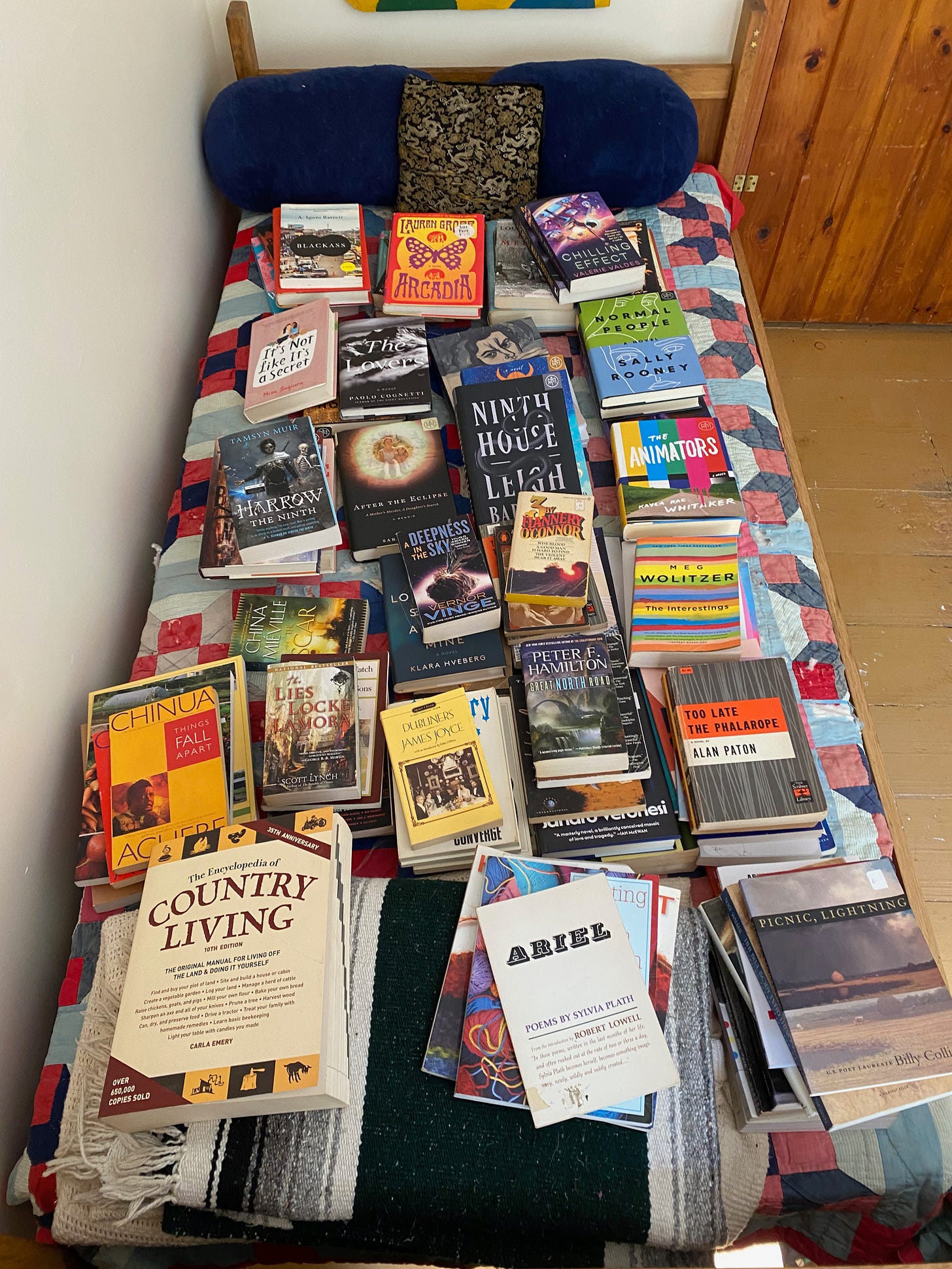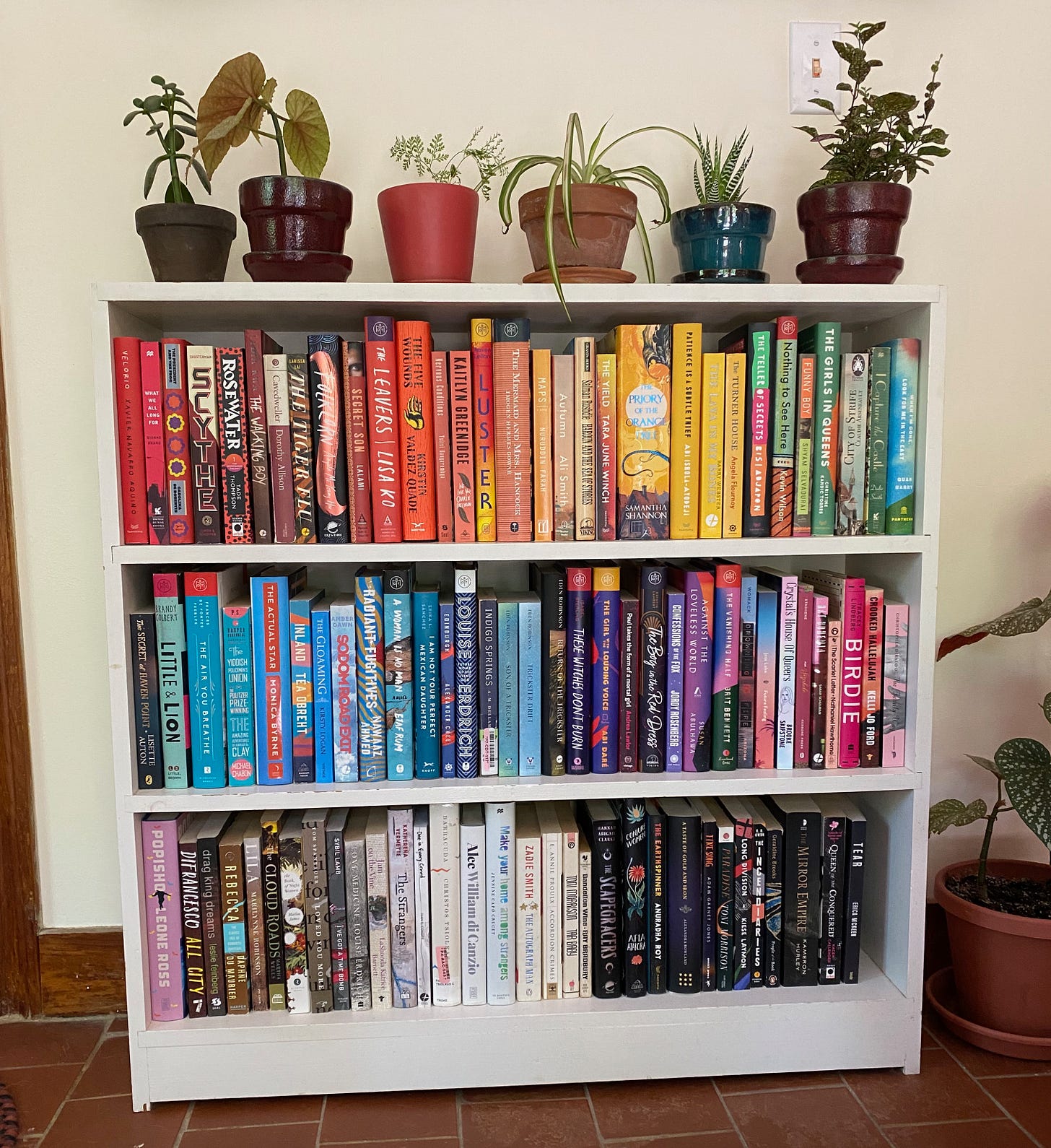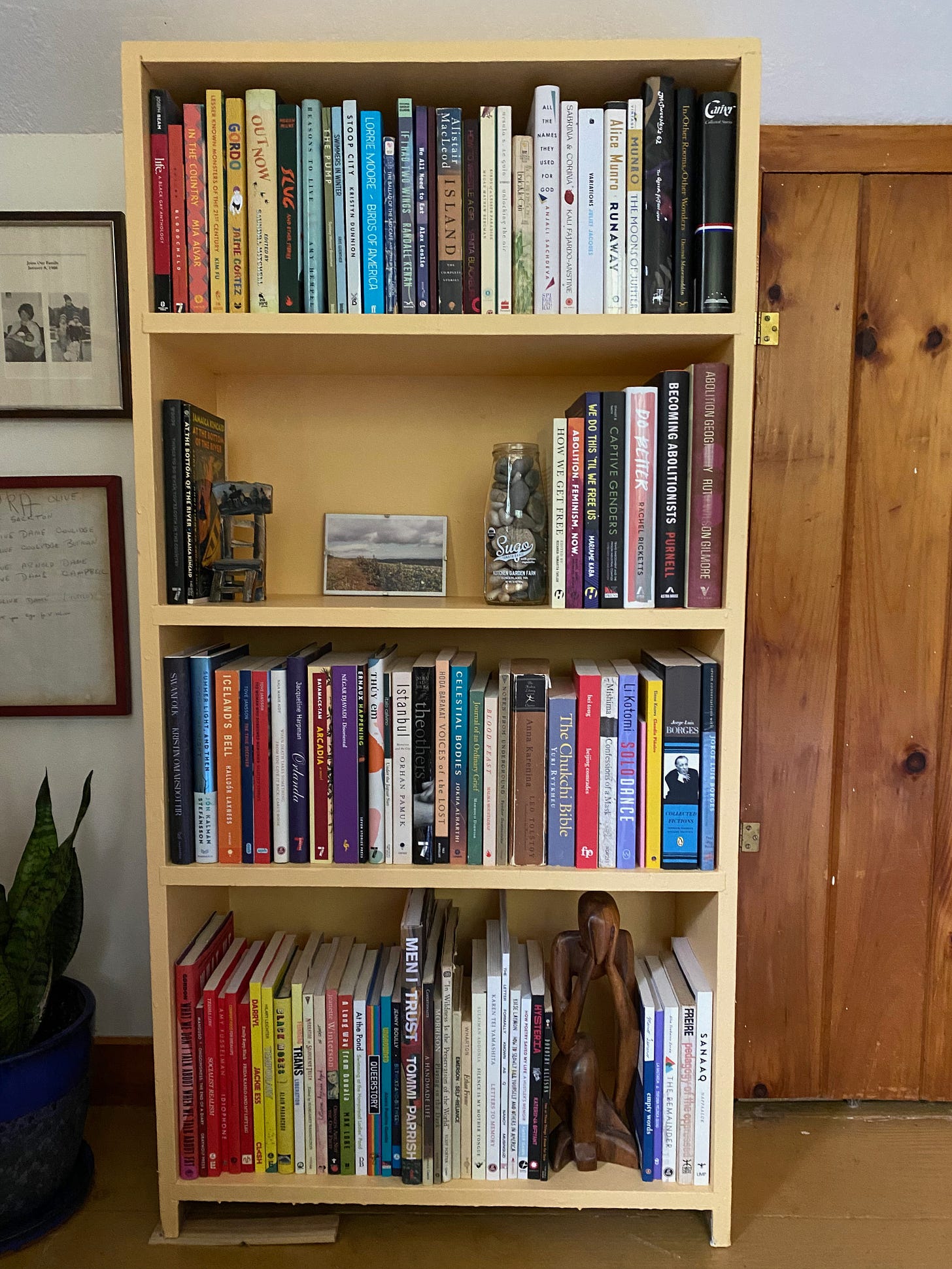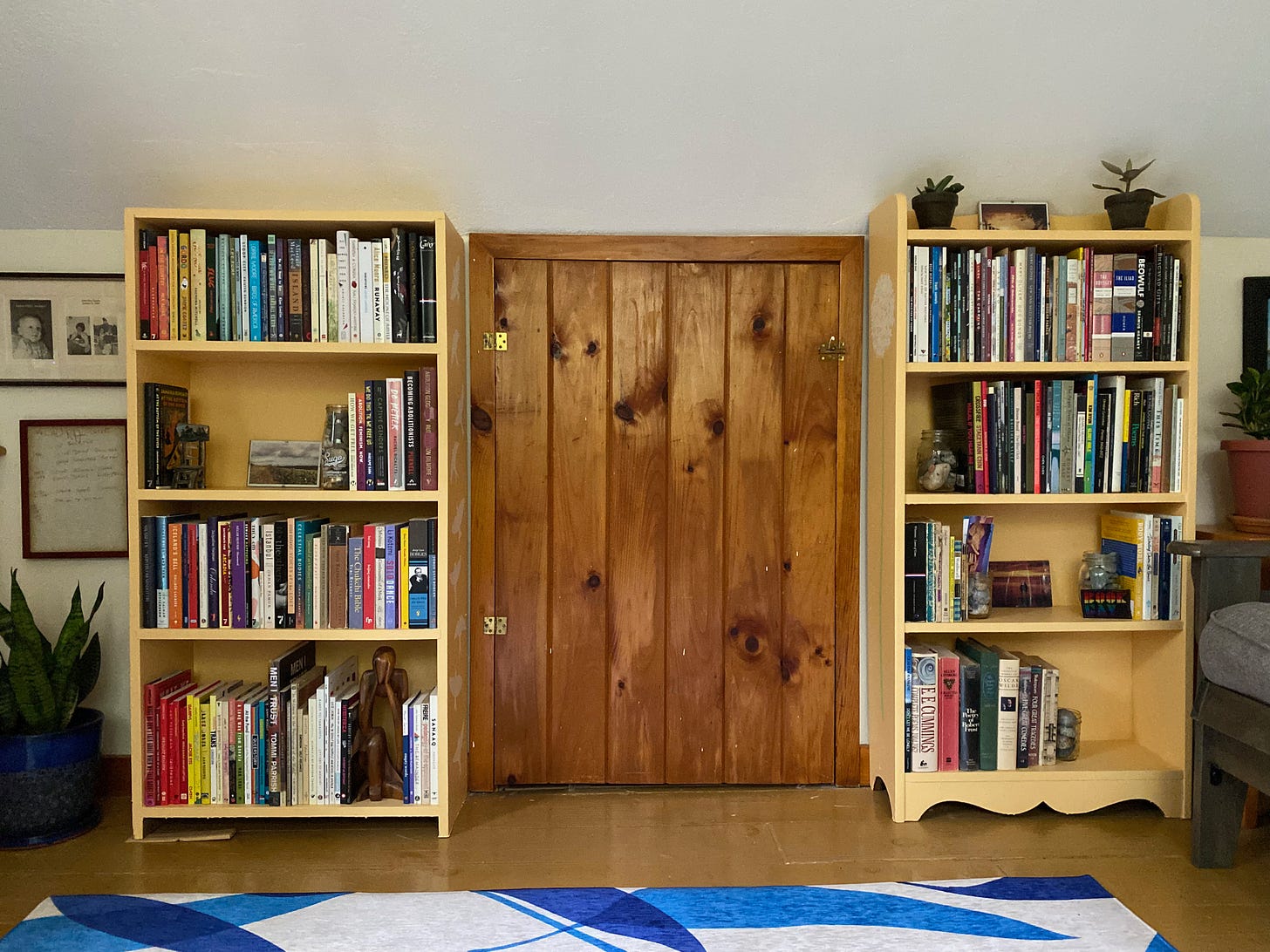Greetings, friends! I’m siting in my office in a sweatshirt as I write this, drinking a second cup of tea and watching the woodpeckers on the tree outside the window. I’m surrounded by newly organized bookshelves, the breeze is cool, and I feel extraordinarily grateful: for this space, for the turning of the seasons. I’ve finally finished the book cataloging project I’ve been immersed in for the last few weeks, so I have a special newsletter for you today!
I decided to catalog my books on a whim, and, unexpectedly, it turned into a monthlong reflection into who I am as a reader and book collector. I feel energized. I walk around my house delighting in my bookshelves in ways I didn’t know were possible. I know my cataloging process won’t work for everyone, but I hope this glimpse into my personal reckoning with my relationship with books will provide some of you with insight, inspiration, and ideas.
It’s a long one, so buckle up! I also documented the process in real time, which you can check out in my insta story highlight.
The Act of Cataloging
This whole project came about because there’s a bookshelf in my office that I’ve been wanting to repaint for a while. So I took all the books off of it, thinking I’d sort them before painting. Sorting them was so much fun that I sorted all the books in my house, shelf by shelf. For data entry, I decided to use Library Thing. I like the simplicity of the interface. It does exactly what I need it to do, and has some fun, nerdy features. There are a lot of book cataloging apps out there, though. My colleague Cassie wrote a great piece about some of the most popular ones.
Sorting
I started by entering all the books on each shelf into Library Thing. Then I went back through all those books, sorting them into piles: definite keepers, maybes, and definite nos. I’ve never gone through all of my books so carefully and thoughtfully. I picked up each one. I flipped through it. I asked myself a lot of questions: Why do I have this book? Do I want to read it? If I’ve read it, do I want to read it again? If I haven’t read it, do I have it just because I think I “should” read it? As an object, does it fill me with joy? What purpose is it serving in my collection?
As I sorted through stacks and stacks of books, some of which I’ve been carrying from apartment to apartment since high school, patterns began to emerge. There wren’t actually that many books I knew I wanted to keep. I felt immediately attached to some books I loved when I was younger, and indifferent to others. I found myself eager to let go of books I’d read and enjoyed recently, not wanting books to sit, unused, on my shelf. Despite slowly curating a collection that mostly reflects who I am over the past few years, my shelves were still full of books that don’t hold any meaning for me. I’ve spent most of my life haphazardly collecting books. The hours I spent sorting through the first shelf in my office (poetry, plays, and epics) made it clear to me that I don’t want to be haphazard about it anymore.
A Goal
I love spreadsheets, so having a record of every book I own is appealing on its own. But the real joy of this project is that it’s been in service to one goal: to create a book collection I love, unequivocally and without reservation. I want shelves that spark excitement and curiosity, that reflect not only who I am now, but who I used to be, and who I’m becoming. I want messy, joyful, complicated shelves. I want living, breathing, changing shelves, not static, fussy ones. I want to be able to run my hands along the spines of all my books, randomly select one, and know exactly why I own it. So I got to work.
The Four Reasons I Keep Books
I came up with four reasons to keep books. They’re not prescriptive; they arose organically as I sorted. It’s not a perfect system, and there are some books that don’t fit neatly into these categories. But these categories kept me focused on my goal, and gave me permission to let go of so many books I only thought I wanted.
Books I’ve Read and Loved (Or Want to Reread)
You’d think this would be the most straightforward category, and, in some cases, it was. Certain books are in a class of their own, most beloved and cherished. Many of these I bought after reading them on audio or via the library because I wanted a copy I could hold in my hands: Exile and Pride, Patsy, The Fifth Season, All This Could Be Different. I ended up creating a whole shelf of books like this (it’s the best thing).
Books I want to reread are a different beast. I read Mrs. Dalloway, and I’ll be honest: it didn’t do much for me. But Woolf excites me. I am not done with her. Mrs. Dalloway stays because I genuinely feel like there is something in it for me, not because I think it’s a book I’m supposed to like.
Books That, As Physical Objects, Spark Joy
There’s a difference between books I love and beloved books. I didn’t have to make a decision to keep Cantoras; it’s a part of me, it stays. But what about White Teeth and Jane Brox’s farm memoirs? What about We Ride Upon Sticks and The Gene? These are books I’ve read and loved, but I’m not especially eager to reread them.
I needed a different metric. The one I came up with is simple and seems to work. Some books, as physical objects, spark joy. When I take The Gene off the shelf and hold it, I’m happy. There’s something intuitive and mysterious going on here that I’ve given up trying to understand. Part of it is the difference between books I loved and books I liked. I ditched The Animators and The Interestings, both of which I enjoyed but didn’t love. But I kept The Lost Language of Cranes, which falls into the same category.
The Animators didn’t evoke any emotion in me when I picked it up. But holding The Lost Language of Cranes, I remembered how monumental every queer book used to feel, how hungry I was for queer stories as a teenager. It filled me with tenderness. So I kept it. My goal isn’t to have pristine shelves. It’s to have shelves that mean something.
Books That Are Part of My Personal Archive
Some books matter to me because of the role they’ve played in my life. These books, though I’m no longer attached to them, honor who I was and where I acme from. My copy of A Portrait of the Artist as a Young Man is cramped with notes. It used to be a beloved book. It isn’t anymore, but it’s still part of the mess of words and ideas that brought me to this moment. I have two copies of Walden on my shelf, both heavily annotated. You will never hear me defending Thoreau, but Walden—the place and the book—is a part of my history. (Regarding Walden: if you don’t take it seriously, it’s hilarious. I laughed out loud multiple times.)
I used to own a lot of Hemingway. I’ve gotten rid of almost all of it, because he was terrible. But I’m keeping A Moveable Feast. I’m keeping it because it is full of my notes—certain pages are so dense with scribbles and underlines that the original text is hard to read—but also because it is a part of me. It profoundly impacted me. I cannot separate the writer I have become with the writer I was at sixteen, when reading that book felt like a gift, an invitation, a lifeline.
In the bookish circles I inhabit, in certain social justice movements, and on the internet in general, there seems to be this desire to erase conflict, to make ourselves perfect, to never admit that we came from somewhere, that we’ve learned to do better. In some cases, this makes sense. You won’t see that evil TERF’s books on my shelves. I won’t lie and pretend I didn’t love Harry Potter as a kid. But now the thought of having those books in my house makes me sick.
There’s a difference, perhaps, between holding onto the work of a rich and influential living author who is actively doing harm, and a dead one (though dead authors can certainly still perpetrate harm). I can’t say I’m proud of the Hemingway on my shelf, but getting rid of it feels dishonest. A Moveable Feast is a part of the record of my life.
I don’t want to pretend that I came into the world fully formed and beyond reproach, that I’ve never made mistakes, that I haven’t been moved by art made by people I abhor. I am made of imperfections and contradictions, and so are my shelves.
Books I Truly Want to Read
Sorting through my unread books was the most fun and the hardest part of this process. I sat with every book for a long time, trying to decide if I actually wanted to read it. I joyfully discarded stacks of books immediately, many of which I bought at library book sales (or claimed from my parents) as a teenager. A battered compilation of Plato. Plays by Tom Stoppard. A whole bunch of novels about straight people, I’ve already forgotten the titles. I don’t have anything against these books, but they clearly don’t belong to me. I know this because I haven’t considered reading them in the twenty years I’ve been lugging them around. Once upon a time I wanted to read them, or thought I should want to read them. Shoulds no longer constrain me. Goodbye.
The Catalog
Library Thing
Shelf by shelf, as I winnowed down my collection, I deleted everything I wasn’t keeping from my catalog on Library Thing. Then I went back and added detail. I now know exactly how many unread books I have (389) and how many read books I have (558). Apparently I’ve read 56% of the books I own—I’ll take it!
You can enter tons of data into Library Thing, but because I’m using it to catalog books I own, and not to track my reading, I only created a few tags and collections. I spent hours pouring through my email looking for bookstore receipts to determine where and when I purchased all my books. Obviously I can’t remember where lots of them came from, but now every time a new book comes into the house, I immediately add it to the catalog, along with the date and where it came from. This data is not especially useful, but having a record of all the indie bookstores I’ve bought from over the years is a joy.
A Place to Dream
I’m also using the catalog as a place to keep track of books I want to replace or buy different versions of. I have a tag for ARCs I want finished copies of; a tag for books that need repair (the copy of The Hobbit my parents gave to me in 1992); and a tag for books I want to replace (I want to reread One Hundred Years of Solitude but the copy I have is a musty paperback with tiny print; I’ll never get through it).
I’ve always love having full bookshelves. I kept so many books I didn’t care about for so long because, when I lined them all up, the shelf still pleased me. This is no longer the case. It turns out that I also love books as objects. My Library Thing catalog is now a place to dream. It’s where I noted that I want the boxed set of Octavia Butler’s Parable books from Seven Stories Press, even though I have two perfectly adequate paperbacks. It’s where I noted that I want to replace my copy of Howl, which is missing a cover, and yes, I want a hardcover copy of Leaves of Grass that is lovely to hold and lovely to look at.
I’m not going to go out and buy any of these books anytime soon. But I’ve never given myself permission to collect books for their shapes and colors and how they feel in my hands. Well: permission granted.
Unexpected Discoveries
Surprises
This process was full of glorious surprises. While sorting, I put The Scarlet Letter in the probably-no pile. But I kept coming back to it. Can I explain this? I cannot. Am I going to read it this month? I am not. But I’m curious, so I’m keeping it. I’ve gotten rid of so many books by dead white cishet dudes, because boring. But I’m holding onto some of them, because of my new criteria for keeping unread books: genuine excitement. I found The Travels of Marco Polo on my shelf, and was he an asshole? Probably. But I picked it up, read a page, and felt an immediate desire to read the rest. I didn’t even know I had it. I didn’t know I had biographies of Maria Mitchell, James Tiptree, Jr., and Harriet Tubman, but now I want to read all of those, too. Discovering what I actually want to read is as much a gift as realizing what I don’t want to read.
Deep Dives
An example: I was trying to decide whether to keep my copy of Ovid’s Metamorphoses. I apparently read the fist 50 pages and heavily annotated them, so I’m attached to the copy that I have. But I never finished it, and I’d like to. I don’t know where my version came from. I’m certain I paid no attention to the translation. So I did some research, and discovered a new translation, by Stephanie McCarter, coming out in November. That’s the one I want to read, because I prefer translations of ancient lit by women. This discovery led me down a Gilgamesh rabbit hole (I want this one and this one) and a Rilke rabbit hole (this one, please).
I am constantly seeing out new releases. I go to the library for them, I buy them. I am never going to stop doing that. But taking the time to look at my collection reminded me just how rich it already is. I’d like to spend a few weeks exclusively reading Gilgamesh translations. This winter, I may do just that. If I hadn’t taken the time to hold that book in my hands and consider whether I really wanted it, the idea never would have occurred to me.
Letting Go
It’s one thing to get rid of books I genuinely dislike or have no interest in reading. I’ve weeded my bookshelves before, and it always leaves me feeling freer and lighter. But this time around, something unexpected happened: I kept putting all sorts of wonderful books in the giveaway pile, without thinking much about it. Most of these were books I’ve read and enjoyed, but don’t feel any particular connection to: The Gospel of Breaking, The Empress of Salt and Fortune, The Four Profound Weaves. I genuinely like having these books on my shelves, but holding onto them feels like hoarding. Somebody else needs them more than I do. They deserve to be read.
I have about 150 books I plan to start giving away via this newsletter in the coming weeks, in exchange for donations to organizations and mutual aid efforts I care about. Stay tuned for details!
Organization
Read vs. Unread
When I moved into this house, I sorted my books, vaguely, into read and unread. But I also did this weird thing where I shelved books I’d had for a long time and wasn’t that excited to read with my read books. I had a TBR shelf with books I couldn’t wait to read, and fiction/nonfiction shelves that were 90% books I’d read and 10% low-priority unread books. Essentially, I was hiding unread books where I’d never find them.
My new system has one unifying factor: read and unread books are separated. I know lots of people sort books this way but it feels revelatory to me. I kept The Scarlet Letter because I’m actually intrigued by it, but I guarantee I’m never going to just wake up one day and decide to read it. I might, however, pick it up while browsing my shelf of unread fiction. The new system is all about putting books where I’ll find them. I’ve created bookshelves that are both beautiful as objects and useful tools.
Books I’ve read are separated into fiction and nonfiction, both sorted by author’s last name. Unread books, also separated into fiction and nonfiction, are sorted by color. I love my rainbow shelves, but they serve a purpose beyond aesthetics. The randomness encourages browsing.
Bookshelves as Library
The principle underpinning the organization of my unread books is simple: I want my shelves to feel like a library. I want to be able to go to certain section—fiction, poetry, nonfiction, short stories—and I want that section to be full of surprises. I want my shelves to become an invitation to linger. I want to be able to get lost in the stacks—in my own house. I want to be able to plop myself in front of a shelf, read the first page of six different books, and come away with something entirely different than what I thought I wanted to read.
An Asymmetrical System
I purposely kept my organizational system simple because sorting by genre has never worked for me. I get too caught up in it. Where’s the line between history and memoir? Do I create a place for essays, or split the essay collections into politics, nature, art? It’s too messy for my checklist-loving brain. I love the simplicity of minimal categories: read/unread, fiction/nonfiction.
But I’ve created lots of exceptions based on what I know about myself as a reader. One shelf of unread books in my office contains:
Short stories: I always know when I want to read a short story collection, so it helps to have them all together.
A small collection of nonfiction books about abolition: I separated these out as a reminder to myself that this is an area I want to devote some time and study to.
Translated lit, organized by language, and arranged in vaguely geographical order, starting in northern Europe and moving eastward around the globe: This brings me an unreasonable amount of joy.
Books under 200 pages, both fiction and nonfiction: I love throwing myself mini readathons of short books.
Other weirdly specific categories are strewn across other bookshelves. Romance gets its own shelf, as does unread romance. The poetry I’ve read is sorted by publisher, not author. I kept physical versions of a few books I know I will only read on audio (Jane Austen, Anna Karenina), so I made a separate shelf for them. My graphic novels and memoirs have their own shelf, and so does Tolkien.
All of these categories are subject to change. If something stops working, I’ll try a new way.
My Shelves
A Finite Shelf of Beloveds
This is my favorite shelf. I pulled all of my most beloved books from all over the house and put them here, along with my collection of Metonymy Press titles. I love that it’s a finite space. If I read a book I love enough to put on this shelf of beloveds, I’ll make space by removing something else. It’s a living record of the books that are moving and shaping me, a constantly changing embodiment of what matters to me. It’s where the pure joy of my current reading life lives.
Books I’ve Read This Year
Before this massive reorganization, this shelf in my bedroom held all sorts of random collections of books that didn’t fit anywhere else. Now that I have plenty of shelf space, I’ve reimagined it. The top shelf is romance and the bottom shelf is library books. In between: all the books I own that I’ve read this year. I love looking at them all in one place. I’m also looking forward to the ritual of shelving them at the end of the year, and starting fresh in 2023.
Unread Fiction & Nonfiction
This shelf used to hold a mix of unread and read nonfiction. It wasn’t my favorite shelf to look at, despite its prominent place in my living room. Now I can’t stop staring!
Poetry
This is the shelf that spurred this whole project, now repainted. The poetry is divided into read and unread. It also houses my writing books and a collection of books I eventually want to replace.
The Read Shelves
These built-in shelves in the hallway are the biggest shelves in the house. It’s where most of the books I read will eventually end up: fiction on the left, nonfiction on the right. The bottom shelf is a collection of beloved SFF and other mass markets, like Anne of Green Gables. The books stacked on the floor are ones I’ll be giving away via this newsletter!
A Living Process
It took me a month to do the initial catalog and I’m so glad it’s done! From now on, I’m going to revisit my shelves every year. My systems will evolve. I’ll let go of some of the books I kept in this round. I’ll shelve all the books I read this year. I’ll reorganize the poetry. My shelf of beloveds will shift. I can’t wait to see what else I discover as I meander daily through my living, changing bookshelves.
I’ll be back next week with a regular newsletter. Until then, if you’ve made it all the way down here, come talk book cataloging with me in the comments!



















ALSO, you know how some people get paid to livestream themselves playing video games and talking smack while other people watch on twitch or whatever? I feel like you should have one of those channels but it’s just you walking around your house talking about books
I think and talk about this a lot with folks. As an avid reader, I think I only have 15-20 books. I'm a heavy library user, and if/when I purchase books, I give them away after. Funny that you mentioned 100 Years - it's one of my Top 5, and I don't even have my copy anymore because it was also a used paperback that broke down after many re-reads. I love talking to readers about their library philosophies.